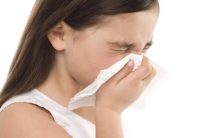Food allergies at an early age occur very often. Often, attacks of the disease in children are reversible, disappearing with age. This is due to the natural processes of growing up that occur in the body of the baby. The gastrointestinal tract adapts to the digestion of food, and the immune system ceases to react aggressively to food components. But in some cases, food allergies can persist for life.
Food allergies in children are common because the digestive system of a child at this age is not fully prepared to digest food. As a result, through the gastrointestinal tract, undigested substances contained in food enter the bloodstream. The immune system reacts extremely unfriendly to the presence of large molecules in the blood. As a result, the child develops allergy symptoms.
Also, a common cause of food allergy symptoms in children is associated with a genetic tendency to develop allergic diseases. This occurs due to the presence of allergic diseases in close relatives of the baby. Those children whose parents are themselves allergic are at the greatest risk. The following rule applies here: the closer the degree of kinship, the greater the likelihood of transmitting an allergic tendency. All parents who panicked while reading these lines need to know that we are talking about an inclination. The presence of any of the relatives of an allergic disease is by no means a sentence for the baby.
Medical research has found that the symptoms of food allergies most often appear in those children who did not breastfeed at an early age. This is due to the fact that breast milk also contains food substances in addition to its own set of substances. Moreover, the latter, being in the smallest dosages, as it were, accustom the baby to food in the future. As a result, the sensitivity of the immunity of a breastfed child to food components is much lower. Moms need to remember that a worthy replacement for breast milk is not expected in the foreseeable future!
There are foods to which children have the highest frequency of allergic reactions:
| animal products |
|
| cereals | containing gluten (oats, rye, barley, wheat) |
| nuts | all types (the most dangerous is peanut allergy) |
| vegetables |
|
| fruits |
|
| greenery |
|
Symptoms of a food allergy in a child
Allergy in children that occurs to food has a variety of manifestations. Not all of them have an obvious connection with the intake of a food allergen. For example, signs of allergy such as fever or coughing can be mistakenly regarded as the result of respiratory viral diseases. It is also more difficult to diagnose the disease by those symptoms, the appearance of which does not occur immediately after the allergen has entered. Often this applies to skin-allergic reactions, which can form within a week, and in some cases even longer.
The symptoms of childhood food allergies are most conveniently considered depending on the organ that it affects. It can be the gastrointestinal tract, oral cavity, skin and other manifestations. Often there is a combination of several manifestations of an allergic reaction.
Gastrointestinal manifestations of food allergy
Children in the first year of life are most vulnerable to the appearance of disorders of the digestive system, suffering from food allergies. Most often they pass along with rashes on the skin. It takes a certain time for the manifestation of symptoms from the gastrointestinal tract. It directly depends on the food itself, how quickly it is absorbed by the child's gastrointestinal tract.
Food allergens can affect the mucous tissues of the gastrointestinal tract, causing various signs of disorders of these organs. In this case, children experience pain in the lower abdomen. They can have various manifestations: sharp and short-term attacks of acute pain, constant dull or aching pain, etc. In this case, constipation often develops, which occurs due to intestinal spasm provoked by exposure to allergens. But sometimes the reverse picture is also possible - frequent and loose stools. The baby may also experience bloating and frequent belching of air, and in some cases even vomiting.
Allergic reactions in the mouth
The organs located in the oral cavity are the first to contact the allergen that has entered the child's body. With food allergies, phenomena such as swelling and inflammation of the tongue, gums, mucous membranes, etc. can be observed. At the same time, these organs increase significantly in size, and in rare cases they can even bleed.
The onset of symptoms of food allergies in the oral cavity often occurs 20-30 minutes after the baby has eaten the allergenic product. Most often, these signs of the disease occur with intolerance to seafood and honey, although they can occur on absolutely any food.
Disorders of the respiratory system and organs of vision
For this disease, the indicated symptoms are not characteristic and are extremely rare. These symptoms are presented by the following phenomena:
- Attacks of dry allergic cough;
- Redness of the eyes and copious flow of tears;
- Nasal congestion, runny nose;
- Attacks of bronchial asthma;
- Nasal sinuses are expanded;
- Intense sneezing;
- The baby breathes mainly through the mouth;
- Eyes and sinuses constantly itchy;
- The child does not sleep well due to bothersome symptoms;
- The eyes become over-sensitive to bright light;
- A sore throat occurs, the child's voice changes.
Skin rash
Skin disorders are the most common food allergy symptoms in children. They are manifested by the appearance of rashes of various shapes and course, as well as itching, irritation, drying of the skin and other manifestations. There are several types of skin-allergic disorders that appear in children with this disease. These include: hives, eczema and dermatitis.
Hives
Urticaria is a skin disease that is characterized by the formation of painless rashes of a rounded shape. They have a slightly pronounced relief, somewhat rising above the surface of the skin. The color ranges from pink to deep red. Those who have seen nettle burns at least once have a clear idea of the symptoms of this disease, since they are outwardly distinguishable. If there is an extensive nettle rash, then this leads to an increase in the overall body temperature.
Dermatitis
Dermatitis is characterized by the appearance of red swelling, on which the smallest dots of a rash with liquid inside subsequently form. They can burst, covering the places of their appearance. The skin with dermatitis itches terribly, over time, the areas can dry out and peel off, falling off with white skin flakes. In children, food allergy dermatitis is most commonly found on the face, cheeks, thighs, neck, chest, knees, and elbows.
Eczema
This skin disease is characterized by the formation of red areas with clearly defined depressions. In these places, bubbles are subsequently formed, which, bursting, form a cluster of tiny holes. For eczema, intense bouts of itching are also characteristic.
General well-being of a child with food allergies
In addition to special signs, food allergies in children also have symptoms of general malaise. These include fever, chills. An allergy in children that occurs to food causes significant discomfort to the child, because of which he becomes capricious, irritable, and does not sleep well. If you notice changes in the behavior and character of your child after eating certain foods, this may indicate that allergic reactions are hidden from the eyes in the child's body.
Quincke's edema
Quincke's edema is an acute development of edema occurring on the inner layers of the skin and mucous membrane. With food allergies, it often develops in children who are sensitive to seafood, citrus fruits, peanuts, honey, and chocolate. The most common swelling of the face, lips, larynx, extremities. Moreover, laryngeal edema poses a threat to life for children. This is due to the fact that with this phenomenon, the airways overlap. The same can be observed with swelling of the tongue. Another danger of this allergic manifestation is the risk of cardiac arrest caused by a sharp drop in blood pressure.
Parents whose children have a predisposition to this phenomenon should carefully avoid contact with the allergen. The composition of each purchased product must be carefully studied. At the slightest suspicion of the development of this manifestation, it is necessary to call an ambulance.















